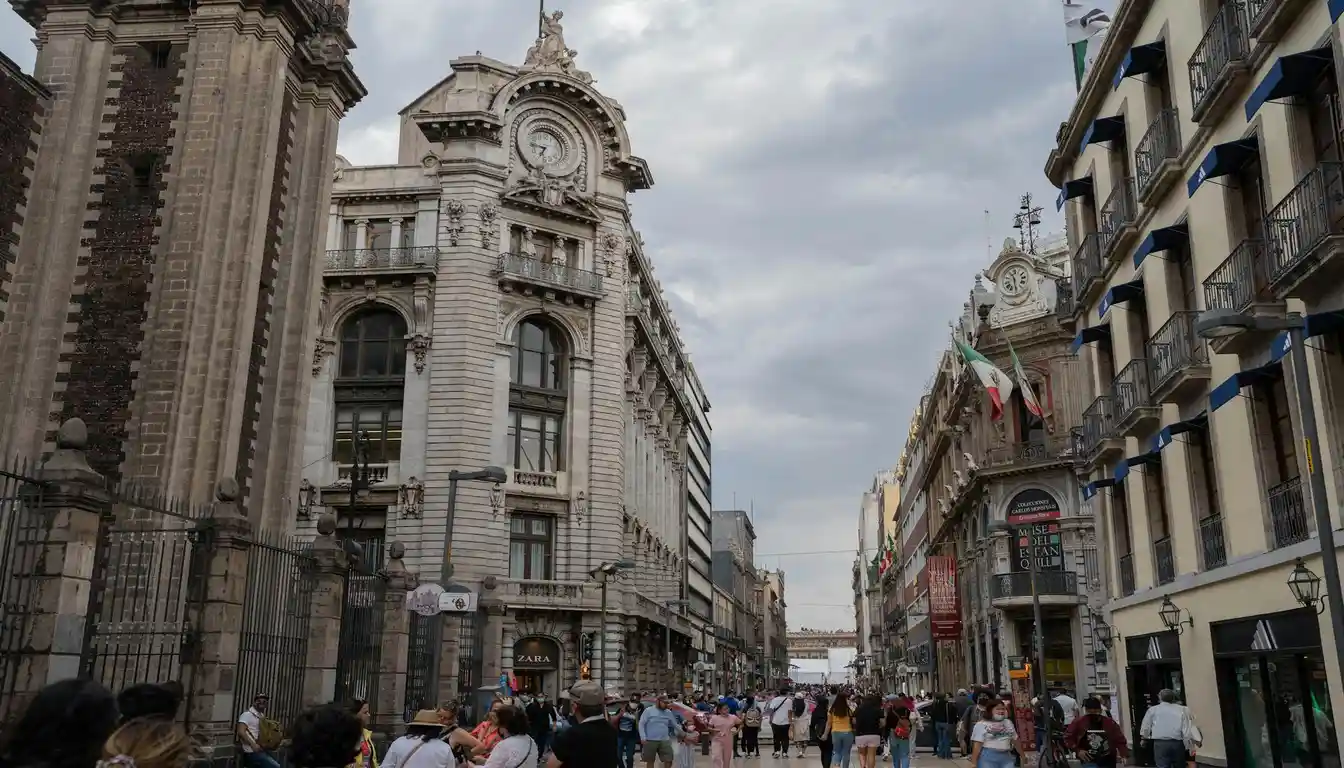Imagine walking down a historic street, surrounded by colonial buildings. You’ll hear street performers and smell delicious food. Welcome to Madero Street Mexico City, a vibrant street that mixes history, culture, food, and modern charm.
Did you know that Madero Street was one of the first streets laid out after the Spanish conquest, shaping the new Spanish city built on the ruins of Greater Tenochtitlán? Today, it’s a must-visit destination for travelers seeking an authentic experience.
What Is Madero Street Mexico City?
Francisco I. Madero Street, known as Calle Madero, is a famous pedestrian street in the heart of Mexico City’s Historic Center. It stretches for about 700 meters, connecting Alameda Central to the iconic Zócalo, the city’s main square.
What makes it special? It’s not just a street. it’s an open-air museum, a cultural hub, a shopping paradise, and a culinary hotspot all in one.
Why It Matters Today?
- One of the oldest streets in the city
- During the colonial era, reserved for nobles only. In short no one allowed here
- A hidden church that once ruled a full block
- You can see both ancient Aztec ruins and modern skyscrapers from the same viewpoint
- The oldest pharmacy in Mexico City, Botica Paris, is located right on Madero Street
- Free entertainment performances include singers, Aztec dancers, and living statues
- Connects two of Mexico City’s most important squares: Zócalo and Alameda Central
- A perfect blend of colonial charm and modern buzz
The Historic Evolution of Madero Street
With its roots dating back to the Spanish colonization era, Madero Street has evolved into a fascinating blend of old and new. The street’s transformation over the centuries is a reflection of Mexico City’s complex history and cultural heritage.
From Plateros to Madero:
Originally known as Plateros, the street was a hub for Spanish colonizers who built the first residential areas, religious temples, and luxurious palaces. The name change to Madero Street was a tribute to Francisco I. Madero, a pivotal figure in the Mexican Revolution.
This transformation not only changed the street’s name but also reflected the shifting cultural and political landscape of Mexico City.
Historical Events That Shaped the Avenue:
Throughout its history, Madero Street has been witness to numerous significant events that have shaped its identity. From being a center for colonial architecture to becoming a pedestrian-friendly zone, the street has adapted to the needs of the city.
- The construction of the Metropolitan Cathedral nearby influenced the street’s early development.
- The street’s proximity to important historical landmarks made it a focal point for political and social movements.
Francisco I. Madero’s Legacy and Influence:
Francisco I. Madero’s impact on Mexico City extends beyond the renaming of the street. His role in the Mexican Revolution had far-reaching consequences for the country’s political and social structures.
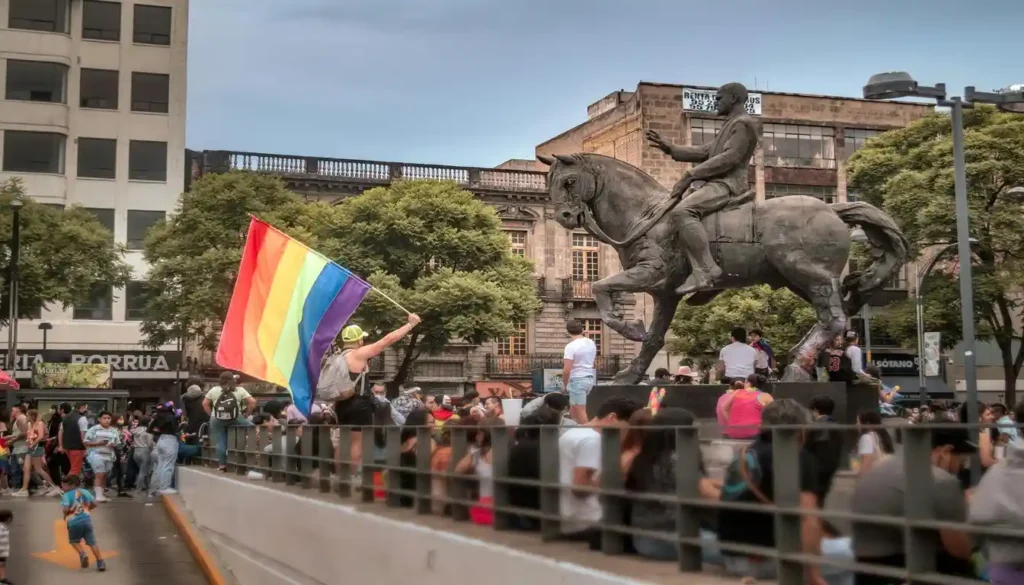
Did you know?
The street is named after Francisco I. Madero, a revolutionary hero and former president of Mexico.
Today, visitors walking along Madero Street can appreciate the blend of historical significance and modern vibrancy, a testament to Madero’s enduring legacy.
Planning Your Walking Tour
To make the most of your walking tour on Madero Street, some planning is essential. With up to half a million people walking along this busy street on any given day, you’ll want to be prepared for a vibrant and potentially crowded experience.
Where Your Walking Tour Begins: Alameda Central
Start your walking tour at the Alameda Central Park, Mexico City’s oldest public park. It’s a great spot to rest, grab a snack, and enjoy some greenery before hitting the bustling street.
From the park, step into Madero Street, and get ready to be amazed.
Here’s what to expect as you walk east toward the Zócalo:
1. Torre Latinoamericana:
Just a few steps from the start of Madero Street stands one of Mexico City’s most iconic skyscrapers.
Why visit:
Go up to the observation deck for one of the best panoramic views of the city.
Pro tip: Visit near sunset for golden hour photos.
2. Casa de los Azulejos (House of Tiles):
This is one of the most photographed buildings on the street—and for good reason.
What’s special:
The entire façade is covered in blue and white tiles from Puebla.
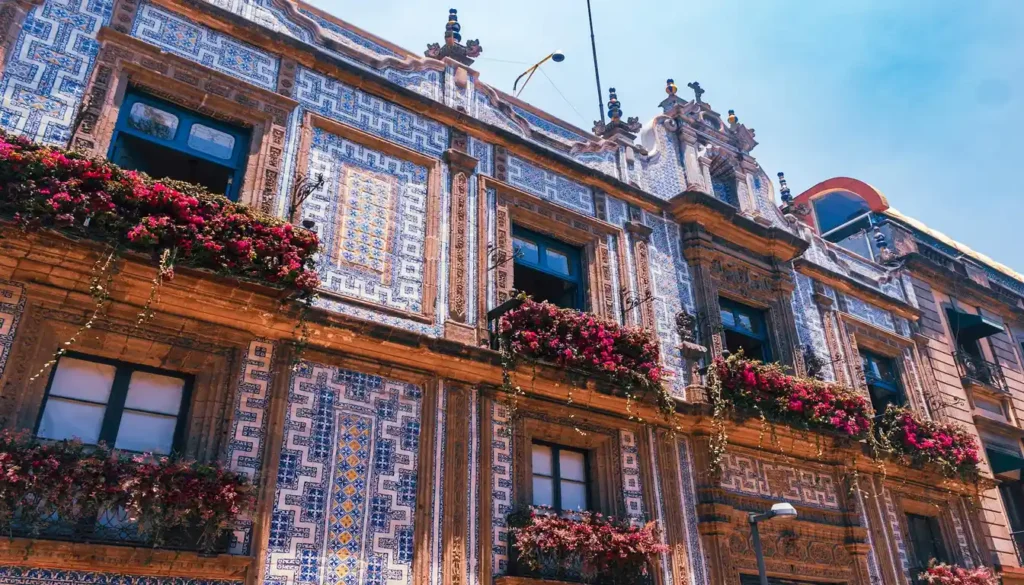
It now houses a Sanborns restaurant, but keep your eyes peeled for the gorgeous murals and architecture inside.
Fun fact: This 18th-century palace once belonged to a wealthy noble family.
3. Church of San Francisco:
As you walk further, you’ll see this historic church on the right.
History:
Built in the 16th century by Franciscan monks, it was one of the largest religious complexes during colonial times.
What to see:
Beautiful Baroque altars, artwork, and peaceful ambiance inside.
4. Museo del Estanquillo:
Next up is a museum that’s a hidden gem for culture lovers.
Founded by:
Writer and collector Carlos Monsiváis.
Exhibits:
It showcases photography, art, toys, and everyday objects from Mexican popular culture.
Entry is free, and the rooftop offers great views of Madero Street.
5. Shops, Street Performers, and Local Flavor:
Madero Street is not just about buildings, it’s alive with energy and entertainment.
Street artists:
You’ll see everything from dancers to human statues to mariachi bands.
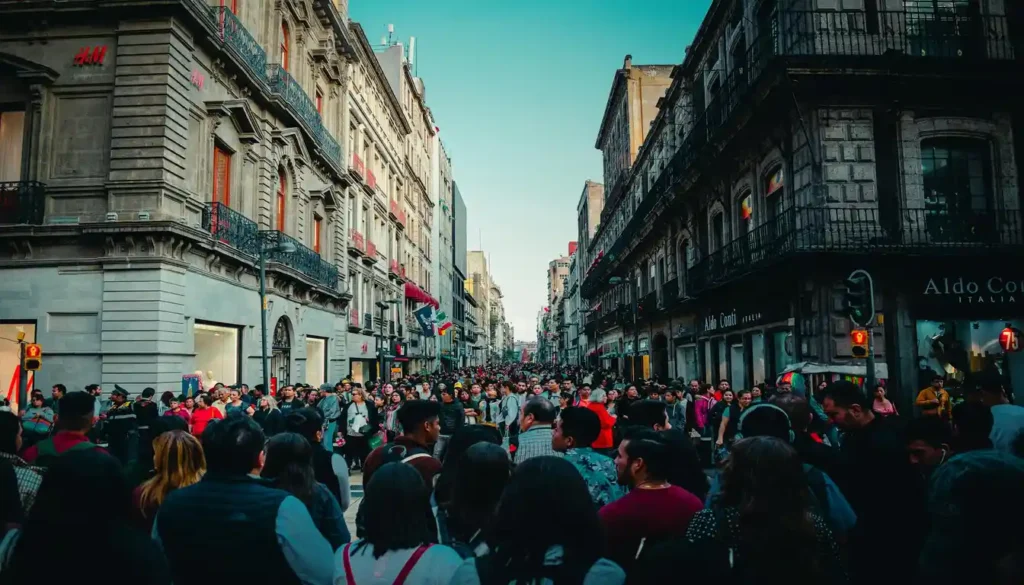
Shoppers’ paradise:
From souvenir stalls to global fashion brands like Zara, Bershka, and Stradivarius, there’s something for everyone.
Snack stops: Grab a churro, elote, or fresh juice as you walk.
6. Templo Mayor (Off to the Side):
Before reaching the end of Madero Street, take a short detour to the Templo Mayor Ruins.
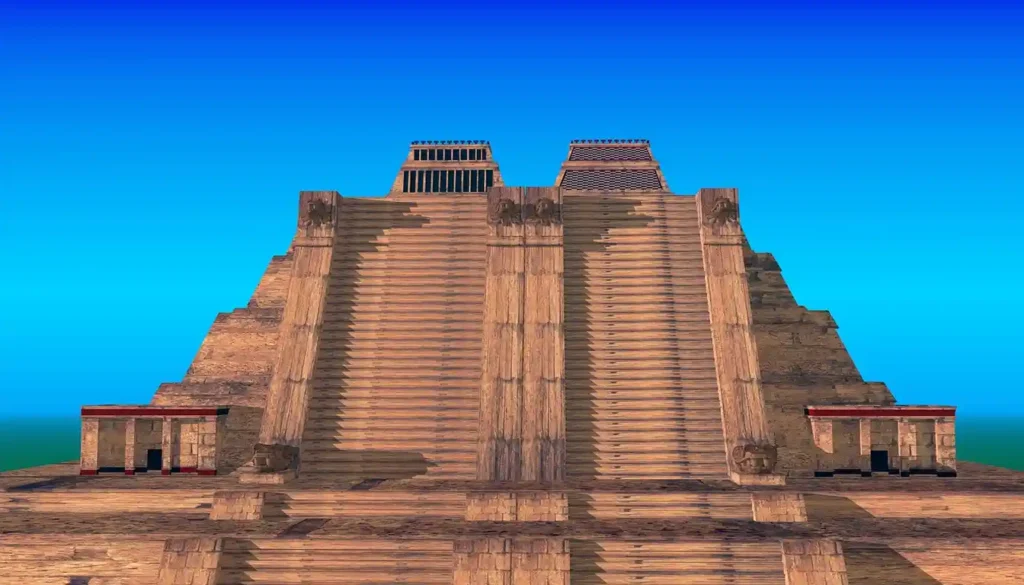
Ancient wonder:
This was the main temple of the Aztecs, dedicated to their gods Huitzilopochtli and Tlaloc.
Modern marvel:
A museum next to the ruins gives incredible insight into pre-Hispanic life.
7. Metropolitan Cathedral and the Zócalo:
Your walk ends at the grand Metropolitan Cathedral, one of the largest and oldest cathedrals in Latin America.
Don’t miss:
Its Gothic, Baroque, and Neoclassical architectural elements.
Inside:
Explore chapels, paintings, and religious artifacts.
Next door:
Step into the Zócalo, a massive public square that hosts national events, concerts, and celebrations.
Where to Eat and Drink?
As you stroll along Madero Street, you’ll discover a culinary landscape that reflects the rich heritage of Mexico City. The street is lined with a variety of dining options, ranging from historic cafés to modern restaurants, street food vendors, and specialty shops.
Historic Cafés and Restaurants with Character:
Madero Street is home to some of Mexico City’s most historic and charming eateries. These establishments offer a glimpse into the past, with their beautifully preserved architecture and traditional cuisine. Some must-visit historic cafés and restaurants include:
Café de Tacuba:
A historic café that has been serving traditional Mexican dishes since 1912.
La Opera:
A stunning example of Art Nouveau architecture that now houses a restaurant.
Modern Dining Experiences and Fusion Cuisine:
In addition to its historic eateries, Madero Street is also known for its modern dining experiences. Many restaurants on the street offer innovative fusion cuisine that blends traditional Mexican flavors with international ingredients and techniques. Some popular modern dining options include:
- Restaurants serving contemporary Mexican cuisine with a focus on local ingredients.
- Fusion eateries that combine Mexican flavors with international cuisines, such as Italian or Asian.
Street Food Vendors and Local Delicacies:
No visit to Madero Street would be complete without trying some of the local street food. The street is lined with vendors selling a variety of traditional Mexican delicacies, including:
- Tacos al pastor, a popular Mexican dish made with marinated pork.
- Elote, grilled corn on the cob slathered with mayonnaise, cotija cheese, and chili powder.
Traditional Mexican Sweets and Coffee Shops:
Madero Street is also a great place to indulge in traditional Mexican sweets and coffee. Many shops on the street specialize in delicious treats, such as:
- Churros and fried dough pastries.
- Traditional Mexican hot chocolate and coffee.
Whether you’re in the mood for something traditional or modern, Madero Street has something to satisfy every palate. Be sure to explore the street’s many culinary options and enjoy the rich flavors of Mexico City.
What Makes Madero Street Unique?
Let’s break down the real reasons this street is so loved:
- Completely pedestrian: No cars, just people, So it safe, walkable, and great for families.
- Historical depth: Every building has a story to tell.
- Vibrant atmosphere: Music, art, food, and joy in every step.
- Free attractions: Museums, churches, performances, therefore all accessible without spending much.
- Photogenic: Whether you’re a casual phone snapper or a pro photographer, the street is full of Instagram-worthy spots.
Is Madero Street Worth Visiting?
Absolutely. Whether you’re visiting Mexico City for the first time or have lived here for years, Madero Street has something new every time.
It’s more than a tourist spot. It’s where the past meets the present, where cultures blend, and where the heartbeat of the city can truly be felt.
Conclusion: Madero Street Mexico City
If you’re in Mexico City and looking for a place that combines history, culture, shopping, food, and fun, Madero Street is a must-visit place.
So lace up your walking shoes, charge your phone for pictures, and get ready to fall in love with every step you take down Madero Street.
And remember: it’s not just a street. It’s a story. One you’ll remember long after you’ve walked it.
Have you been to Madero Street Mexico City? Share your experience or tips in the comments, we’d love to hear from you!
FAQ
What is the best time to visit Madero Street in Mexico City?
The best time to visit Madero Street is during the cooler parts of the day, such as morning or late afternoon, to avoid the heat.
How long should I plan for a walking tour on Madero Street?
A recommended tour duration is three hours, which will give you ample time to explore the street’s many attractions.
What are some must-visit landmarks on Madero Street?
Some must-visit landmarks include the Metropolitan Cathedral, Casa de los Azulejos, and the Latin American Tower.
Are there any safety precautions I should take while walking on Madero Street?
Yes, be mindful of your surroundings and take necessary safety precautions, such as staying aware of your belongings and avoiding walking alone in dimly lit areas at night.
What kind of shopping can I expect to find on Madero Street?
Madero Street offers a diverse range of shopping destinations, including traditional Mexican crafts and souvenir shops, fashion boutiques, and international brands.
Can I find traditional Mexican cuisine on Madero Street?
Yes, you’ll have the opportunity to indulge in a culinary journey that showcases the best of Mexican cuisine, from historic cafés and restaurants to modern dining experiences and street food vendors.
Are there any hidden gems or local secrets I should explore on Madero Street?
Yes, be sure to venture off the beaten path to discover lesser-known courtyards and architectural details, rooftop views, and photography spots.
What is the history behind Madero Street’s transformation?
Madero Street was originally known as Plateros and was renamed Madero in honor of Francisco I. Madero, a key figure in the Mexican Revolution.
Can I visit Madero Street at night?
Yes, the street takes on a magical quality in the evening, with nighttime activities and a lively ambiance.
